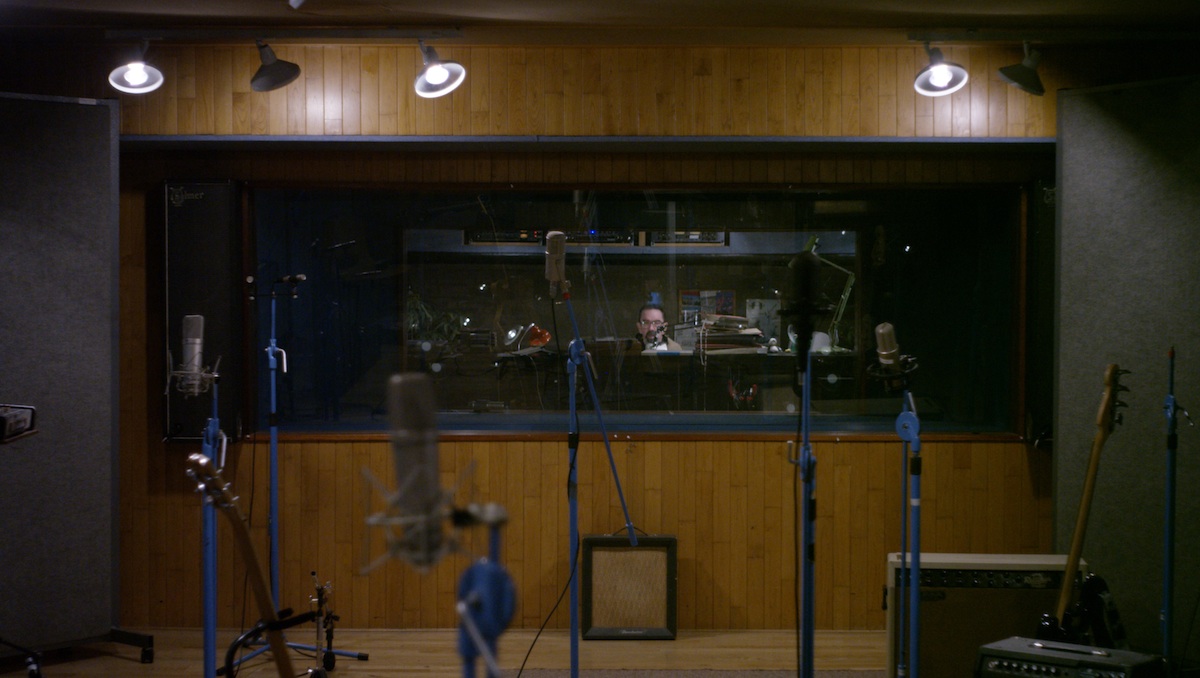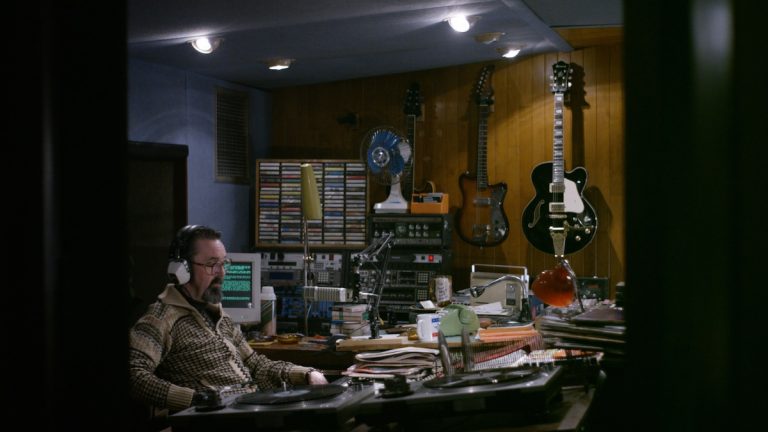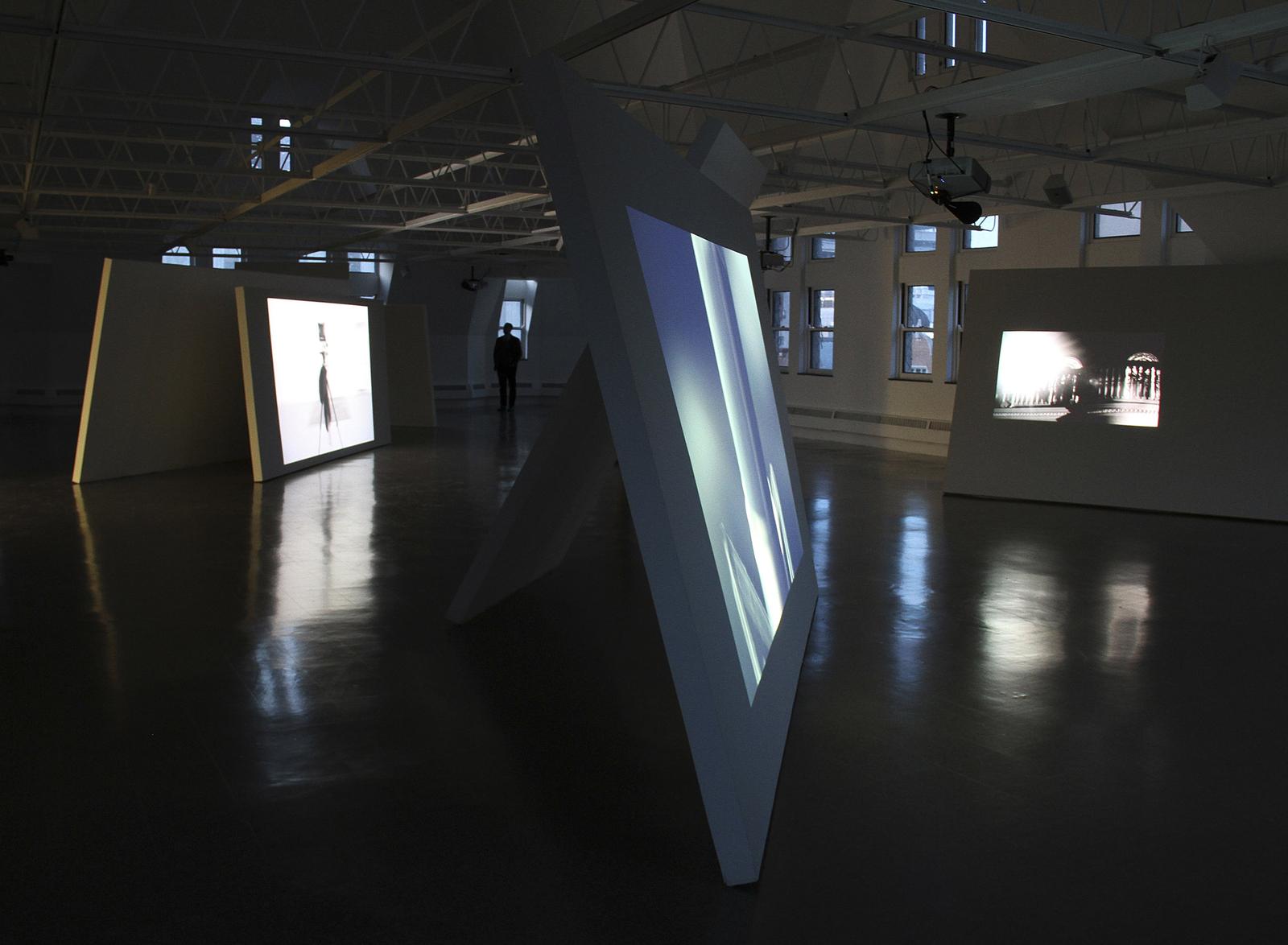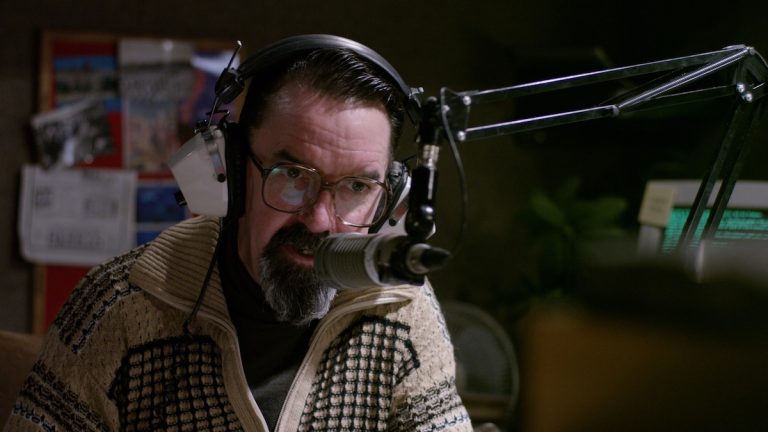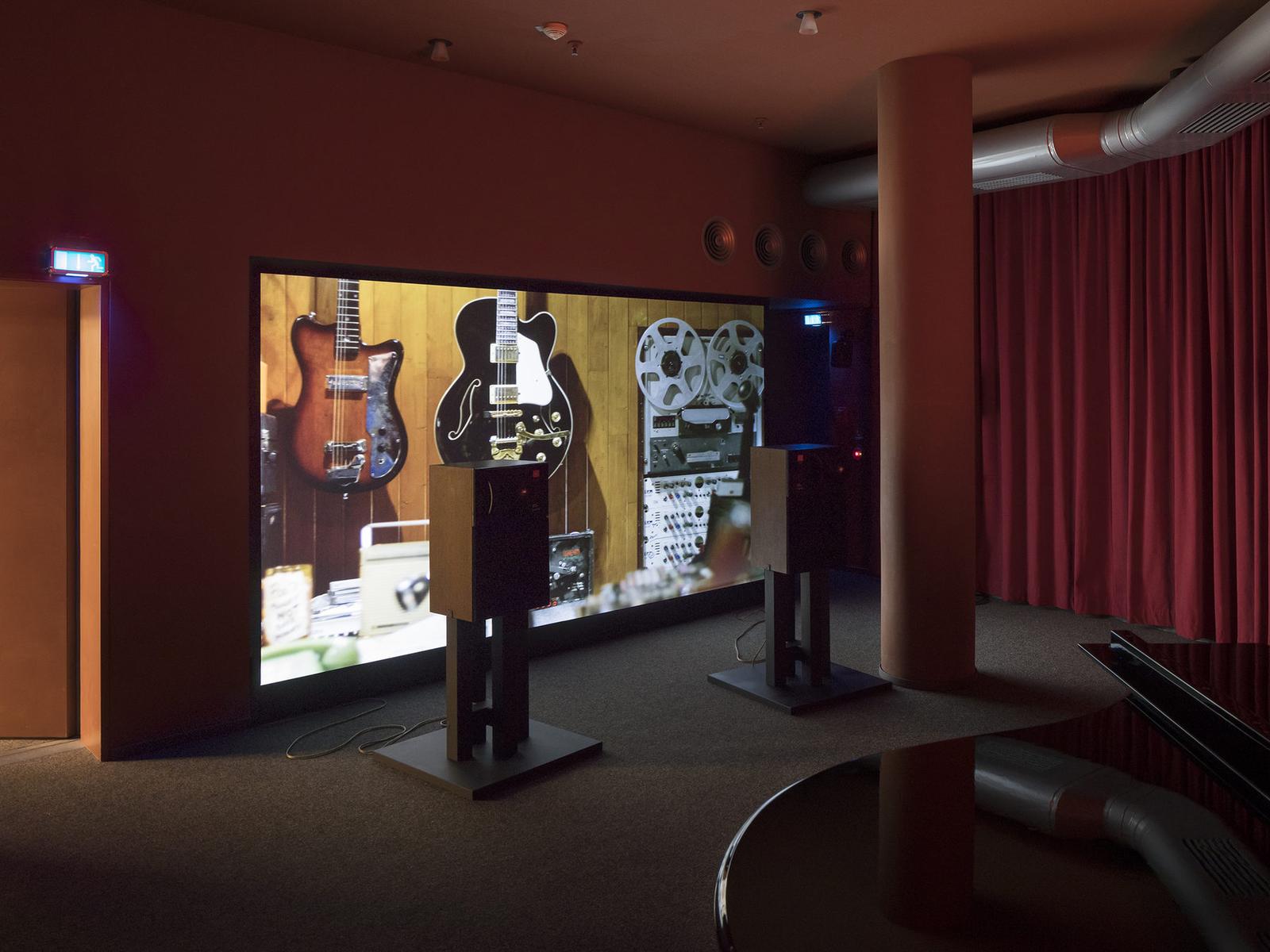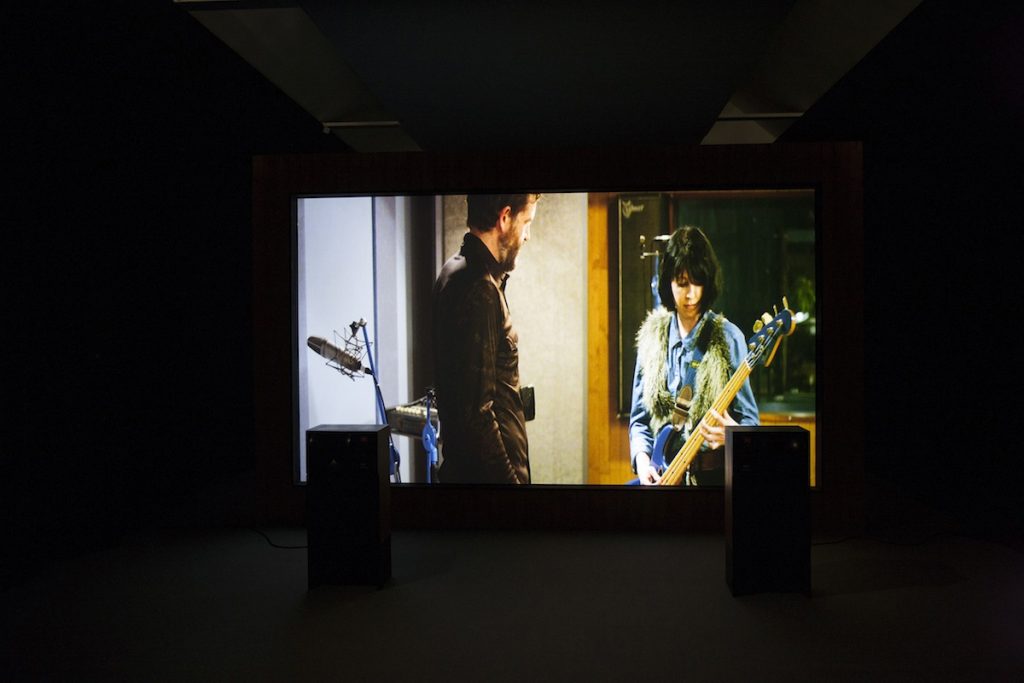In the summer of 2017 Gerard Byrne premiered In Our Time at Skulptur Project Münster in Germany. In late 2017, the work was shown at the Lisson Gallery, New York, and at the Kerlin Gallery, Dublin. Joan Fowler viewed the installation at the Kerlin and this became a reference for some further thoughts.
On the face of it, In Our Time (2017) feels as though it is from a different trajectory when compared to Byrne’s recent video works. Gone are the art historical and institutional allusions and citations; in their place, the video’s set and sound are literally steeped in popular culture. The installation was commissioned for the Münster Sculpture Project of 2017 and, according to Byrne, idea and location coincided: the site was in the depths of the town’s public library, a soundproofed room with red curtains and a grand piano, installed so that people could practice their music.[1] The room was therefore both public and private in its function. Byrne had this in mind as he made the video, the set for which loosely emulates the soundproofed studio space of a radio station apparently somewhere in the United States, and in a timeframe which drifts back and forth between the late 1960s and early ‘80s. The video is the centrepiece of the eventual installation, set in a soundproofed studio, itself projected in a soundproofed room.
We are introduced to the video, situated in this ambivalent past, largely through the person of a male disc jockey, (played by an Irish actor who appears to speak with an American accent); he is the locus of the video’s sound and vision. Clips of a diverse range of popular music is heard along with what appears as the DJ’s delivery into the microphone. What is voiced is the mix of content that commercial radio made its own – music, interspersed with news, weather reports, and advertisements – but these flit across time and space. Period is marked by the news items and advertisements, space by reports of weather conditions across large segments of the United States. We get snippets of American commercial radio with its syndicated elements, so it is impossible to pinpoint the DJ’s locale. Apart from a slightly perverse phone-in element in which the middle-aged DJ baits schoolgirls about their boy interests, the viewer is left blank about his audience beyond the enclosed world of the studio, though in fact it is we, the viewers, who are his audience. What is amplified is the difference between listening to radio and watching the video: the latter somehow intensifies the conditions for the former even though the ‘broadcast’ occurs only in the fictional space of the video.
Despite this apparent immersion in popular culture, Byrne is consistent in his interests and there are indeed continuities between In Our Time and his early films and video works, for example, Why It’s Time for Imperial, Again (1998-2002) and 1984 and Beyond (2005-07). Take the seemingly minor question of dress. The actors’ clothing in these earlier works gesture towards the fashions of the 1960s and early ‘80s but, clearly, historical specificity is not essential. The same is true of In Our Time. The DJ wears a cardigan which looks as though it might have been picked up at a jumble sale, while the other participants – ‘techies’ who, at intervals, in a space adjacent to the radio booth, move on and off camera, set up, tune, and dismantle the kit as though for a studio session – are also in outmoded apparel more reminiscent of amateur theatrics than the real thing. This nearly but not quite approach to former dress codes is a reminder that, in Byrne’s work, naturalism, or mimesis, or indeed Hollywood restyling, is not imperative. A Brechtian disturbance of what constitutes dress code is at play.
There are also subtle differences from the early videos. Where New Sexual Lifestyles (2002) and 1984 and Beyond replicate what were for the time serious discussion sessions published in Playboy (1973 and 1963 respectively), the script for In Our Time consists largely of extracts compiled from radio archives across time and location. Radio has content yet lacks physical presence; it can be aurally experienced anywhere within range. Where the earlier work is more tied to time and place, here the radio, as beamed across the airwaves, has roots in locality but is also resonant with what will become present, a much looser, ethereal, and ultimately global condition in which human contact may be more ‘interactive’ but also less physical, more depersonalized.
A recent development is a shift away from multi-monitor and multi-screen installations towards concentration on a single screen, high definition production. The format Byrne has chosen for the viewing of In Our Time is one relatively large screen projection which makes for an installation closer to the ‘Black Box’ environment favoured by many artists working in video – It remains to be seen whether it will re-emerge as part of a multi-screen, multi-video installation into the future. That the viewer will concentrate on the single screen in In Our Time suggests a desire to capitalize on the capacity for detail provided by high definition. In the video there is intense visual focus on the control booth of the radio station and this runs through the thirty minutes, the approximate length of the edit before some segments of either sound or vision are replayed. Hence, the construction of the set required extensive preparation, and clearly, critical attention was given to what was included. The camera pans the space very slowly taking in the audio mixers, the decks and cables, the detail on cassette and vinyl covers, the transistor radio, the microcomputer, as well as the DJ. Here too, the historical accuracy of these details is not absolute. For example, while the artists featured on the cassette tapes are resonant of the period, the mix suggests not so much an American collection as something rather more Irish. In fact, production occurred in a sound studio in Dublin and the contents for the set were probably sourced locally. This offsetting of total accuracy appears in several forms through Byrne’s work but, in this case, the care in achieving near authenticity is as great as if fidelity to a real US radio station interior was the goal.
It emerges that over the course of a decade, Byrne’s videos have evolved away from his use of the jarring qualities of early video. Similarly, his use of multi-screens within the installation space where the same work runs with the same material from different camera angles or different edits which serve to break the narrative flow. In the most recent work the capture of every detail absorbed through the high definition digital camera is a comparatively smooth, singular experience. Lest the viewer is seduced into an excess of visual pleasure in watching In Our Time, it appears Byrne has introduced another means of interrupting visual flow with puzzles over the accuracy of time, place, and chronology. Puzzles are also evident with the aural experience where, for example, the DJ’s introductions do not match the music played.
Byrne has continued to expand his expertise in moving image as evidenced in the constant upgrading of the technology, employment of production teams, and here, in the meticulous construction of the set. However, he stops short of emulating mainstream, naturalistic cinema where the objective is to engross the audience in storyline. In, In Our Time, Byrne uses a technique that incorporates the clock-time of the viewer. As is still common on many radio stations, the presenter periodically broadcasts the time. The surprise of the video is that the time as apparently announced by the DJ is the time of the viewer. This cut from the time-space of the video to what we see as ‘real’ time is made possible because the video is programmed to the Internet and to universal standard time, our method of measurement and our means of representing time. This re-production of the practice of providing standard time through radio is time synchronized to the networked computer and the Internet. The move is in a sense non-intuitive in that the Internet is the most global of technologies, lacking in the material substance which might form our perception of ‘real’ time. This redeployment of the older radio technology for In Our Time means that at intervals, when the time is announced, the viewer is prompted out of the time of the video back to what we think of as real time: the time of the viewer.
The punctuation of the time of the video to the time and space of the viewer is not merely a gimmick. In the discussion session organized to mark the opening of In Our Time in New York, Byrne commented that the Internet and the rapid advance of information technologies profoundly implicate our empirical experience, yet we fall well behind in our understanding of the extent of the changes these make in our lives. In Our Time invites the viewer to draw back from the embrace of the video, hopefully back to the viewer’s self-awareness and her relationship to the work. While intellectually, these considerations pose much broader questions about the pace and purpose of technology, Byrne’s first concern is in the apparatus of installation – the video, how it is projected, and the physical environment. But also, in this case, the video is the main vehicle for the psychological conditions of the work. Yet the video is a projection; it is unreal. Where Byrne has stated that his work as an artist is grounded in the materiality of the installation, there seems an acknowledgement that the technology is a major determinant and that, on the broader front, technology is the main force in shaping our futures.
In, In Our Time, as in other of Byrne’s installations, there is an uneasy coexistence between the video, its apparatus, and the support structures. With A thing is a hole in a thing it is not (2010) and Jielemeguvvie Guvvie Sjisjnjeli (Life Inside an Image) (2016), Byrne emphasized the importance of, in theatrical terms, the ‘props’, the constructions he builds as supports or adjuncts to the screens on which the video is projected. These props, reminiscent of Robert Morris’s plywood pieces of the mid-1960s, serve in part as Byrne’s continued homage to Minimalism. They continue Minimalism’s stress on installation as an encounter between work and viewer and, in Morris’s case, in tandem with his study of phenomenological writings. For Byrne, the ‘props’ have a physical role. Not only are they a reminder of ideas expressed by Minimalist artists, they intervene to partially forestall the seduction of the viewer into the time and space of the video. For Byrne, they are a contingent solution to a problem involving the material grounds for art at a time when the immateriality of technological means seems inevitable, and indeed, art of the moving image has shifted inextricably towards the cinematic. The ‘props’ in In Our Time though operate differently to Byrne’s previous work. The sound for the video, (the DJ, segments of music, the ‘techies’ tuning instruments, their muffled conversation), comes via eight speakers positioned around the curtained room to the front, sides and rear of the viewer. This all-encompassing sound may seem to contradict Byrne’s use of props to inhibit over-identification with the video, but two of these speakers, which are particularly large, are positioned in front of the screen, and partially block the viewer’s vision. These bulky forms are props with a ‘real’ function in the provision of sound, unlike the artifice of earlier versions.
The site-specificity of the basement room in the Münster public library may have provided the original impetus, but such specificity is persistently thwarted in Byrne’s video. The intent is signalled by the amorphous title. “In Our Time” speaks to time/space without precise boundaries, geographical, political, or personal. And yet the video recalls a remembered past on the individual level and collectively. They are remembered, and so have a life in the present. The video invokes a time when radio was more pre-eminent than today, a time when it was a significant cog in a well-established distribution network in commercial music across the United States. The DJ’s script suggests a broad network which, in turn, begets a broad audience. While the popular music in circulation between the late 1960s and early ‘80s is Byrne’s point of reference, such circulation of music also contains within it the seeds which lead to the development of the globalized economy to have emerged by the close of the millennium. Since the 1980s the balance between public and private has swung emphatically in the direction of the latter. Simultaneous with the privatization of tracts of the public realm is the global expansion of branded and generic goods, of culture, and this is, strictly speaking, ‘our time’. Perversely, the something-for-everyone, oldies and newbies range of music broadcast via this imaginary radio station conflicts with the emptying out of time and space as well as the levelling out of value – an end to standards by which some artefacts are adjudged to be of higher, more enduring, quality than others – that are symptomatic of the new global economy of late capitalism. In Our Time gives an intense focus on a sealed room, a control room where the connection with an outside world is via the airwaves. That is, to an imagined community that lives only in our heads. It poses the question: What is the mode of address in the title, ‘In Our Time’?
**
At face value, In Our Time is a sympathetic exploration of an aspect of popular culture that is past its heyday. In straightforward mode, the viewer, after three or four thirty-minute sessions, can assimilate sufficient information through sound and vision to ‘get’ the general drift. (There is a striking contrast with the multi-monitor/screen presentations of Byrne’s earlier videos, where the ‘mobile spectator’[2] attempts to join a narrative as she moves between screens dispersed around the gallery space.) In this mode the title, In Our Time, may be taken in a loose, common usage sense: familiar popular music conjures memories of a time and a place, or again, popular music, which everyone recognizes, is shared experience. In other words, it can be seen in the singular or in the plural. The title may be also interpreted in more layered ways. The video is suggestive of a past where radio falls within a still lingering sense of society where one of the characteristics is mass communal activity. These activities include listening/watching/reading the mass media: watching the same programmes or reading the same newspapers.
Related to the ‘mass media’ is the concept of, ‘the masses’. In the west, in recent times, national institutions of the mass media, especially newspapers but also radio and television, have seen substantial reductions in their circulation and their power of influence; concurrently ‘the masses’ is increasingly obsolescent as a descriptor. This is in part related to the blurring of the category, ‘working class,’ but many other factors are at play. Among these is the introduction of neoliberal rules on competition in the marketplace and the emergence of alternative forms of communication. Significant in its direct effect on the individual, or the subject, is the extraordinary process of individuation of social life that has emerged, particularly in the wake of changes such as the development of the personal computer in the 1980s and the commercialization of the Internet from 1998. Given the changes on society over the past generation, the question that follows is how is the sense of the self and of its other affected? Has there been recalibration in respect of the possessive pronoun, ‘our’?
Byrne attaches importance to the conditions of exhibiting his work, the relations between installation, gallery, and viewer. One may note a shift in gear from his installations which project a viewer moving between screens to the relatively still viewer of In Our Time who sits/stands before the large screen. Ostensibly, the latter is the more stable subject. In the catalogue interview for an installation at the Whitechapel Gallery in 2013, he raised the question of the gallery space as venue: “…how can you continue to find a critical use for it? …Tesco supermarket has a fairly precise sense of its customers and the choices they make, as indeed does Amazon. My guess is, that in general, the type of person that might visit a gallery is far more arbitrary, despite truisms about elitism, populism, etc.”[3] Byrne avoids identifying the viewer, but his specification of what she is not is interesting: the gallery experience is to be treated as open-ended; the viewer is the diametric opposite of the marketing techniques big business exerts on customers.
In a contributing essay to the same catalogue, Lytle Shaw draws a different image of the viewer. In his inquiry into Byrne’s five screen video projection, A thing is a hole in a thing it is not (2010), Shaw considers the subject matter, Minimalism. He contends that the contemporary viewer cannot enter the mindset available at the historical moment of the making and exhibiting of Minimalism as it was filtered through the lens of phenomenology or the gestalt. Shaw writes that Byrne and the contemporary viewer remake Minimalism in contemporary terms (clearly, this author is not concerned with art historians or even art critics who will view Minimalism in, among other readings, teleological terms). Shaw refers to a shift from the ideal spectator present in Robert Morris’s writings of the time, to the identity politics more recently coming to the fore in which class, race, and gender are factors to be considered in the making and reception of art.[4] While, of course, phenomenology is not at issue in the historical sweep of In Our Time, a work which celebrates the ambience of popular music, Shaw signals a change in the conception of the subject in which identifications such as class, race, and gender may be relevant in the interaction between artist, work, and viewer.
In general, what may be said of Byrne’s approach is that he prioritizes the physical nature of the installation space while, in this work, video is the principal medium and the theme is based on radio transmission. The latter are primarily non-physical. Put another way, embodiment and critical capacity are important, while, at the same time, modern media are the mediums of choice and are used to full capacity. These elements could be said to represent purposeful contradictions or, maximally, the juxtapositions may bring forth the possibility of critical inquiry in the reception of the installation. At the same time, he has already set limits on methods to be used: the viewer is not seen as a consumer to be targeted in the manner of the marketplace. As a principle, this red line may seem too obvious to mention: the gallery remains a space held in high regard, if you will, it is beyond mere commerce. The fact that commerce was raised at all warrants further attention. The contention underpinning what follows is that there are connected real and immanent adverse pressures on the functions of the gallery, not only financial in how it pays for itself, but on the subject who enters the gallery and her self-identity. To paraphrase the title of WJT Mitchell’s book which asks what pictures want, here, what do viewers want?
It may be noted at the outset that one of the retailers identified by Byrne in the quotation above paved the way for online selling. When compared with Lytle Shaw’s comment that identity issues emerged as important in how contemporary art is understood, the difference with the online way of doing business – how the consumer identifies herself/himself in relation to a group or class – becomes mere data fed to the algorithms. That is, personal relations and identities are reduced to information about personal inclinations, these are matched with others, then applied to the business of selling products. For political theorist, Wendy Brown, the ‘economization’ of relations is about ROI (Return on Investment). In her book, Undoing the Demos : neoliberalism’s stealth revolution, the implications are taken much further; she argues that neoliberalism is the now dominant feature of Euro-Atlantic governance. ‘Economization’ is a development whereby subjects are ‘dedemocratized’ as economic interests replace politics. She writes, “…neoliberal rationality disseminates the model of the market to all domains and activities – even where money is not the issue – and configures human beings exhaustively as market actors…”.[5] Brown traces these processes through its evolution from liberalism, and through the institutions of state from the law to education. She acknowledges that ‘neoliberalism’ eludes definitive description:
Yet in its differential instantiation across countries, regions and sectors, in its various intersections with extant cultures and political traditions, and above all, in its convergences with and uptakes of other discourses and developments, neoliberalism takes diverse shapes and spawns diverse content and normative details, even different idioms. It is globally ubiquitous, yet disunified and nonidentical with itself in space and over time.[6]
Brown’s account of neoliberalism as amorphous rather than concrete, (“…its unevenness, its lack of self-identity, its spatial and temporal variability, and above all, its availability to reconfiguration…),[7] means that arguments like hers can be readily dismissed as fantastic, particularly by those on the right of the political spectrum. Yet, Brown’s argument has the capacity to provide explanatory force for the many who have struggled in multiple aspects of their existence, whether it is writing applications or the conditions they experience in the job market. ‘Our time’ is changing, and for homo oeconomicus, self-preservation or self-interest trumps the common interest of investing in society in general.
“Once upon a time, in the era of the mass media”, writes the theorist of new media, Wendy Hui Kyong Chun, “the world was divided into ‘we’s’ and ‘they’s’”. As mirror images of each other, “They were mass subjects: dense aggregates that were, or could be treated as, uniform, as the same throughout”.[8] In re-evaluating Martin Heidegger’s delineation of ‘I’s’ relation to ‘they’, Chun argues that in new media the ‘I’ and ‘they’ become ‘YOU’. While this YOU may engage in social media from the privacy of her home, online she connects with other YOUs. These interconnected YOUs form networks; ‘YOU’ serves in both the singular and the plural. Chun writes, “Internet users are curiously inside out – they are framed as private subjects exposed in public”,[9] This ‘inside out’ is most evident in social media where users take to revealing their private feelings. It is a breakdown between public and private. New media, ‘N(YOU) media’, replace mass media, the ‘we’ has become YOU.[10] In the age of the computer, memory becomes storage, and storage becomes Big Data: YOU are registered due to YOUR habits; YOUR role is the production of statistics: “YOU are a character in a drama called Big Data”.[11] If Chun’s means of representing the effects of new media are a challenge to the reader, most of us are already passively aware that we are being monitored, and most of us continue to use it regardless.
Chun’s distinction between YOU and networks and ‘we’ and communities is similarly stark:
Networks are based on YOUs value: a series of interconnecting and connected YOUs. Since YOU in its plural mode still addresses individuals as individuals, networks are very different from communities, which create a new identity, a ‘we’, from what is held common (even if, as Maurice Blanchot has argued, that ‘what’ is incommensurability).[12]
For Chun, the significant spread of neoliberalism isn’t so much the economization of society as its dependence on the technological. The key is the networks. Citing Margaret Thatcher’s (in)famous remark that there is no such thing as society, Chun writes of the role of networks in, “…neoliberalism’s vision as collectively dissolving society”. Further, “networks allow us to trace if not see – that is, to spatialize – unvisualizable flows, from global capital to environmental risks…”.[13]
A central theme of Chun’s book is that of habit. Habit is, “things that remain by disappearing from consciousness”.[14] Her use of the word ‘habit’ may be illustrated by the Internet user’s interaction with the keypad or touchpad: she is conscious not so much of the movement of her fingers as what appears on the screen. Whether orthodoxly or not, the movement made with the fingers was learnt, assimilated, and moved from consciousness. Chun’s point is that not only do we have habits in where we go and what we do online, YOU connect to individuals LIKE YOU, these are captured and deployed in Big Data, (as “indications of collective inclinations”[15]), but we have habits that remain with us. While these may or may not have been colonized in Big Data, we can put these to more effective use than that which appears in the current offerings on social media. Where the marketplace presses us on the ‘need’ to keep updating our lives to create “new habits of dependency”[16] in order to remain up-to-date, which is where we were, this habituation, this dependency, is not the sole output. For Chun, habits, things that were once new and are now “undead”, operate like ideology. But unlike Althusser’s account of ideology,[17] here, habits are personal and embodied. She notes the shift in meaning that has occurred in how ‘habit’ is cast with a shift from habes (to have) to addictio (to lose).[18] She writes of “inhabiting the habitual”, of lingering in those places. This opens the possibility of reimagining ‘we,’ and of creating habes. Chun has indicated how choices, over and beyond social media, can be exercised.
**
A useful comparison may be made between two of Gerard Byrne’s videos from either end of his career to date: Why it’s time for Imperial, again (1998-2002), and In Our Time. The early work transcribes a supposed dialogue, published as a promotional insert in the November 1980 American edition of National Geographic magazine, between the Chairman of the Board of the New Chrysler Corporation and Frank Sinatra. The purpose of the dialogue was to sell a new model of Chrysler car, the Imperial, and the nature of the discussion is very much in the boys ‘n toys idiom. Byrne employed two actors to literally repeat the text as published in the magazine while they walk through a near derelict post-industrial landscape. What is absent in the tone of the actors’ dialogue is any real enthusiasm for the car’s electronic wizardry which the advertisement was meant to convey. The effect of this somewhat monotone discussion is that it acts as a break between text and viewer, the opposite of what was originally intended. Instead of the viewer’s identification with the narrative, and ultimately the car, what may be called distantiation occurs. If It’s time for imperial, again positions the viewer as averse to the promotion, In Our Time is far from straightforward. There is a seductiveness in sound and vision, but this is segmented and therefore broken by what Byrne refers to as the modular structure of the work; these discreet edits pull back the viewer from the lure of the music and the high definition close-ups. Where It’s time for Imperial, again is a tale of two capitalists who the viewer interprets as ‘them’, not ‘us’, the DJ of In Our Time who, although white and male, plays a generic figure that many viewers will have a connection to via the media. It serves as just one example of the expansive connectedness with media that we have had all our lives and become part of what or who we are. In Our Time is redolent with lots of metaphors of inside and outside but this is the most important. This is the inside-out stakes. It involves what kind of ideology we want to reproduce.
